

The Best & Worst Times to Visit Spain in 2024 (Our Take)
Written by: Author Andrew Helling | Reviewed by: Sandy Mitchell

Andrew Helling is a licensed pilot, travel enthusiast, and the founder of Travellers Worldwide whose travel expertise has been quoted in countless publications across the web. Armed with a laptop and a Wi-Fi connection, he loves exploring the world with his wife and son and is always on the hunt for cheap flights and new adventures... Learn More

Sandy Mitchell is a travel expert and the content reviewer/fact checker at Travellers Worldwide. Using the experience she gained working in the travel industry for more than 20 years, as a travel agent, travel marketing executive, and cruise school administrator, Sandy fact-checks and reviews each of our guides to ensure they're as accurate and helpful as possible... Learn More
Posted on Last updated: May 1, 2024 - Travellers Worldwide is reader-supported. If you buy a product we link to, we may earn a commission. Learn more
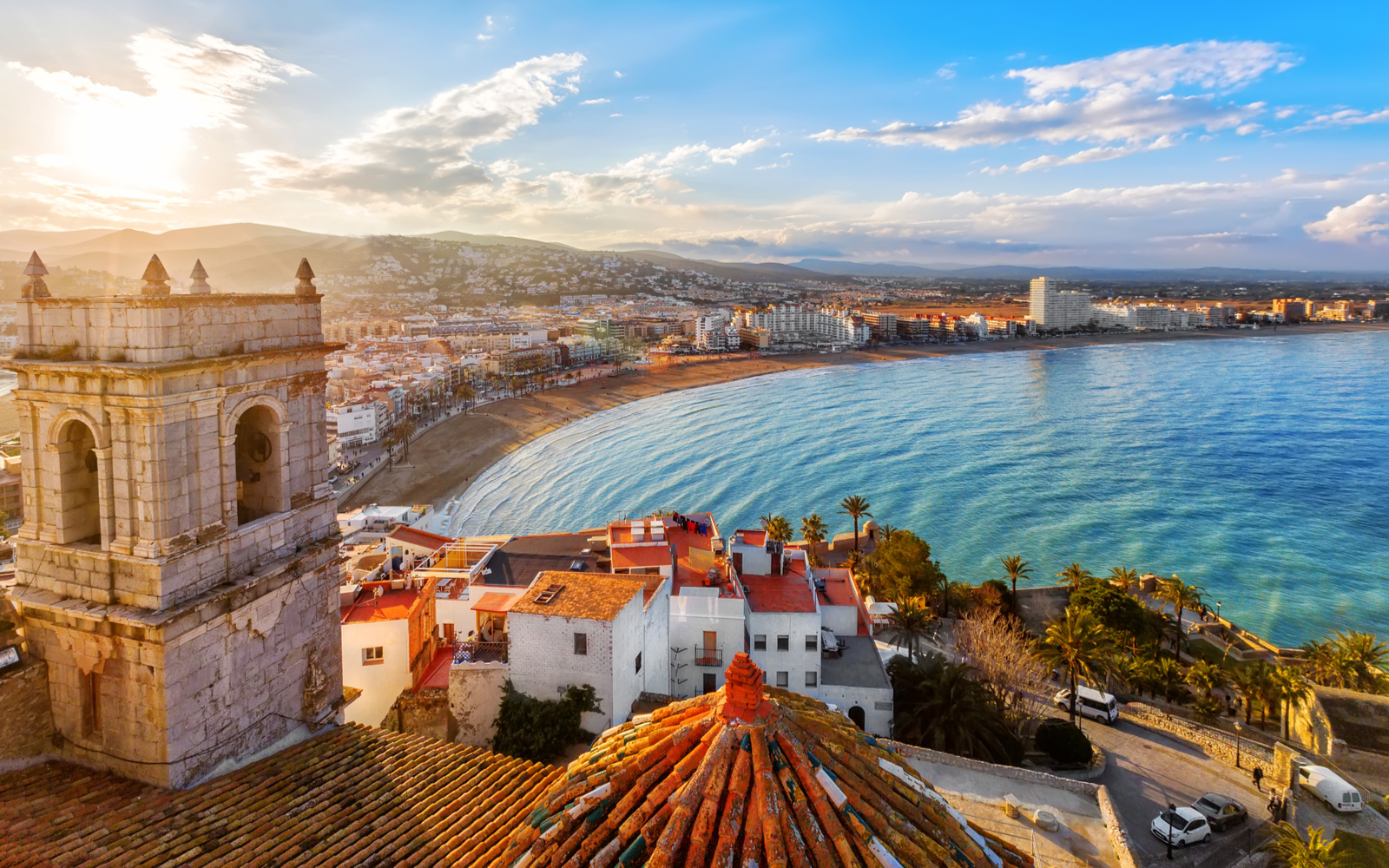
What's the best time to visit Spain?
The best time to visit Spain is between May-June or September-October, with each shoulder season period offering mild, warm weather and plenty of events, like the Ibiza Medieval Festival and National Day festivities. Crowds and prices aren’t at their peak during these months, so you can enjoy an affordable, laid-back trip with sightseeing and beach days on the coasts and islands.
Spain is delightfully diverse with rich history and architecture, world-famous cuisine, picturesque landscapes, and colorful cultural traditions that have stood the test of time. But if you’re planning a trip soon, you’ll need to know the best time to visit Spain.
Seasonal climates are the first consideration when picking out the right travel dates. Spain isn’t huge — a bit smaller than the state of Texas — but elevation and proximity to the coast can affect the temperature and how much rain (or snow) different regions get throughout the year.
Spain has an incredibly varied landscape, from sun-soaked beaches on the coast and offshore islands to the Sierra Nevada mountains in the south. So while one month can be perfect for Barcelona or Canary Islands beaches, it could still be cold and snowy down south.
Other trip planning considerations are cost and crowds. Peak season periods mean higher prices on hotels and flights, while the off-season is when you’ll find better deals and fewer tourists at hotels, restaurants, and attractions in Spain’s most popular cities.
All these factors fit into the puzzle that is determining the best time to visit Spain. We’ll show you the overall best months along with the cheapest, least busy, and worst months for a trip to Spain below.
You’ll also get to see what you can expect during each period as far as weather patterns, costs, crowds, and things to do. This will help you pinpoint the right travel dates for your trip to Spain and make the most of your time in this beautiful country!
Overall Best Time to Visit Spain
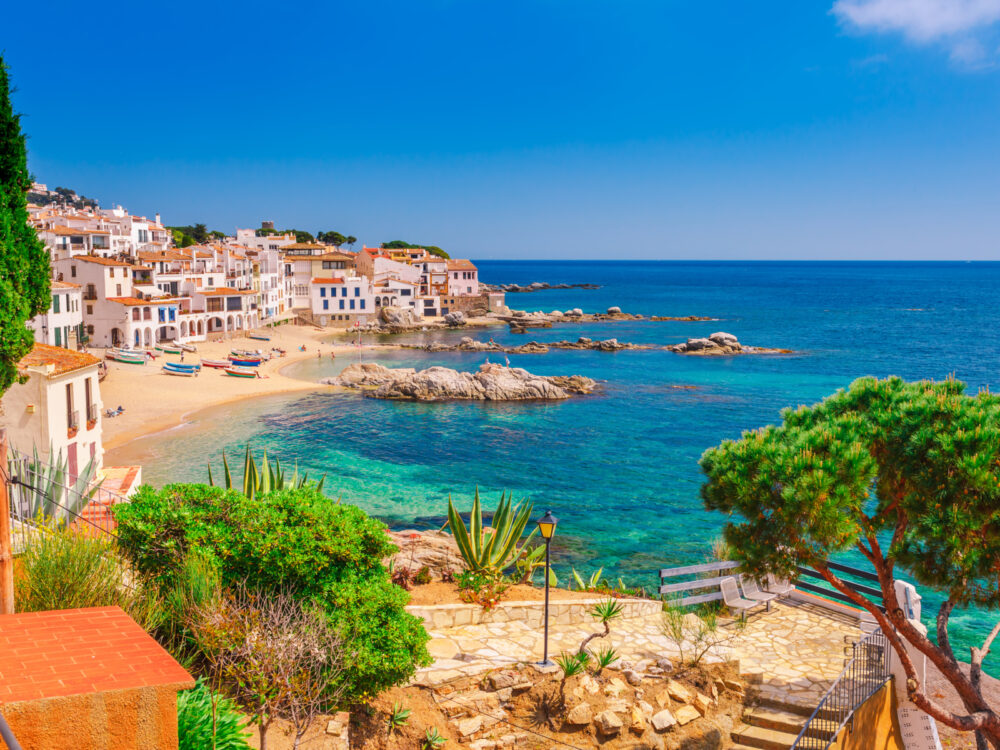
Oleg_P/Shutterstock
The best time to visit Spain is May to June and September to early October. These shoulder season periods see warm, mostly dry weather that’s ideal for sightseeing and exploring major cities, coastal and island beaches, and outdoor activities.
The weather across Spain varies quite a bit in terms of rainfall, but average highs generally hang within a 10° range nationwide, no matter the location. By visiting between May-June or September-October, you’ll avoid the hottest months of the year with highs in the 90s:
- May: 65-75°F; 2-9 rainy days
- June: 71-84°F; 0-6 rainy days
- September: 73-82°F; 2-7 rainy days
- October: 67-74°F; 5-11 rainy days
There’s a little more rain in the northern and western regions in May, September, and October, but the most-visited cities, like Barcelona, Madrid, and Ibiza, usually get the lower end of the rain averages.
This is the best time of year to visit Barcelona for sightseeing and to hit the golden coastal beaches. Hang out on La Barceloneta while things are warm and lively. Explore famous museums, like the Picasso Museum, and awe-inspiring architecture and parks, like Gaudi’s La Sagrada Familia and Parque Guell with its whimsical tilework.
This is the perfect time to walk around Barcelona’s historic and funky barrios (neighborhoods), sample some seafood paella, enjoy flavorful tapas late at night, or take in a flamenco show to really immerse yourself in Spanish culture.
You won’t find a better time to enjoy Mallorca, one of Spain’s Balearic Islands with idyllic beaches and mountains, world-famous nightlife in Palma (the capital), Moorish and Roman palace ruins, and medieval cathedrals and villages built from stone.
Head to Playa de Muro or Playa de Alcudia for picturesque white sand and turquoise waters with tons of beachfront amenities as views of the mountains surround you. Secluded coves, like Sa Calobra, offer a break from crowds with dramatic cliffs and rock formations.
Party-centric Ibiza is excellent during May-June and September-October since you’ll skip the busiest months of July and August but still enjoy warm weather and a lively atmosphere at the clubs, bars, and restaurants.
While milder September and October are some of the busiest months of the year in Spain, they’re not the most expensive. In fact, you can score great deals on hotels and flights during all the best months to visit!
Take a look at average hotel prices (courtesy of Google Hotels ) and the lowest airfare by month (data from Skyscanner ):
- May: $208/night; flights from $213
- June: $253/night; flights from $384
- September: $216/night; flights from $314
- October: $196/night; flights from $288
Another great thing about coming during the best months of the year is that you’ll be able to participate in and attend some of the biggest festivals of the year in Spain. Here’s what’s going on between May-June and September-October:
- Madrid Day (May 2) means many businesses close across the city as the main plazas close to traffic for street parties and concerts with a big fireworks display the night before
- Ibiza Medieval Festival (mid-May) in Ibiza’s Old Town, Dalt Vila, steps back in time with entertainment, markets, food and drinks, and more in the beautiful island setting
- Fiesta de San Isidro (mid-May) honors San Isidro Labrador (patron saint of Madrid) with pilgrimages to the saint’s remote hermitage, dancing, street parties and concerts, and food booths
- Primavera Sound (early Jun) is a 4-day indie rock festival in Barcelona, featuring dozens of bands from local favorites to more well-known names
- Sónar Festival (mid-Jun) is a big electronic music and dance festival in Barcelona that brings some of the city’s coolest music venues to life with digital hits, workshops, and more
- Haro Wine Festival (late Jun) sees locals and tourists donning white outfits to squirt and drench each other in red wine with hoses, water guns, and buckets in northern Spain
- Granada International Festival of Music and Dance (Jun-Jul) is a month-long festival of classic music and dance traditions from around the world, from Portuguese fado to the Paris Orchestra
- Fiesta de la Merce (Sept) honors the patron saint of Barcelona (Our Lady of Mercy) with a 5-day festival featuring parades with floats and giant puppets, concerts and music in the streets, art displays, food, and fireworks
- National Day (Oct 12) is also Armed Forces Day with military parades in Madrid (attended by the King, Queen, and Prime Minister) along with an airshow, music, traditions, food, and dancing; most businesses close down today
Hotels and flights are more affordable during May and October if you’re hunting for a deal. But June and September offer weather that’s a little drier and warmer for beaches (if that’s in your plans) and may be worth spending a bit more.
Cheapest Time to Visit Spain
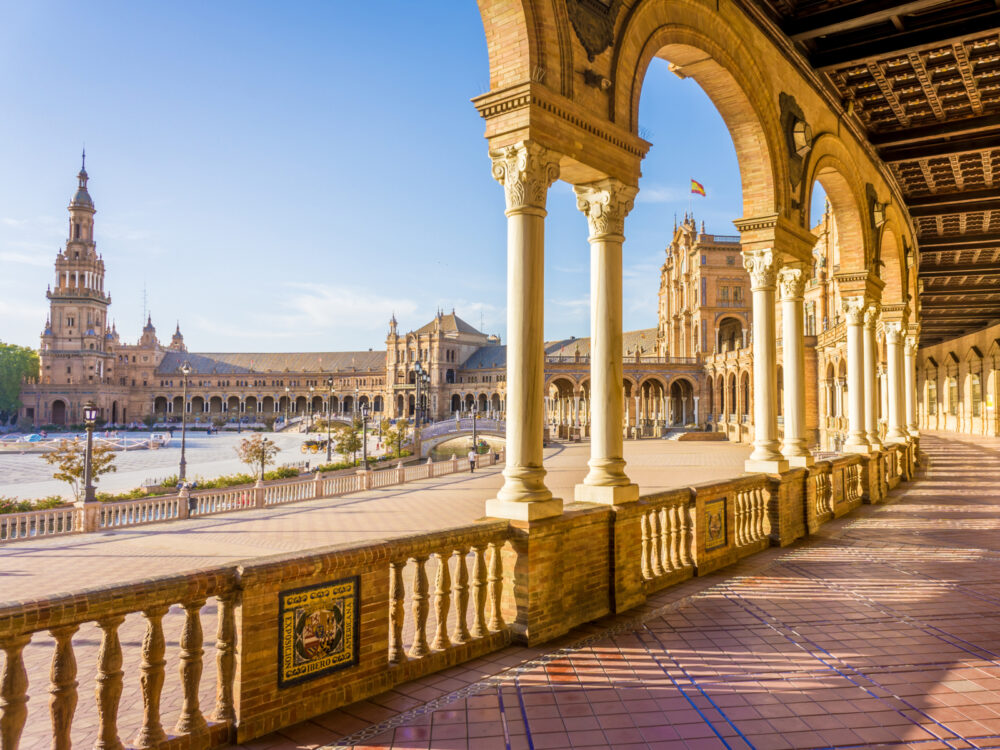
LucVi/Shutterstock
The cheapest months to visit Spain are April-May and September-December. Balmy May is the cheapest month for airfare, while cool, rainy December sees the lowest prices on hotels across Spain.
While saving money is always a plus, there are some downsides to visiting during the cheapest months. Rain may interfere with outdoor plans if you’re visiting northern or western Spain during April, May, September, or October.
- April: 60-70°F; 4-10 rainy days
- November: 58-67°F; 4-12 rainy days
- December: 51-63°F; 3-12 rainy days
December is one of the busiest months of the year to visit Spain as holiday travelers flock to the country en masse ahead of festivals and Christmas events. Big crowds, the need to book hotels and flights well in advance, and longer wait times at popular attractions should be considered.
But on the bright side, some of the best months of the year in terms of weather, smaller crowds, and things to do also happen to be some of the cheapest — May, September, and October.
This is a great time to go to Tenerife in the Canary Islands for outdoor adventures, like hiking to the observatory in mountainous Teide National Park . Relax on a beach with golden or black sand, stay at a luxe resort in Los Cristianos, and explore lush 18th-century botanical gardens.
Valencia, on Spain’s central-east coast, is nice this time of year. Stroll the Mercat Central to browse goods and food and see amazing architecture like the Gothic 15th-century La Lonja de la Seda de Valencia palace and Serranos Towers that remain from the original 14th-century city walls.
Visit Seville in southwestern Spain for its Plaza de España square with networks of canals (rent a rowboat to ride down them) and colorful benches decked out in artsy Andalusian mosaics. If it’s rainy, duck into the Museo Militar to learn about military history.
While pricing varies by month, you’ll find the best deals on hotels and flights during these months. Here’s what we found in Google Hotels and Skyscanner airfare data:
- April: $167/night; flights from $463
- October: $196/night; flights from $288
- November: $161/night; flights from $307
- December: $158/night; flights from $288
The cheapest month to visit Spain overall is December. You could spend as little as $1,394 for a 7-night stay if you’re able to score cheap round-trip airfare. November, April, October, May, and September follow.
We’ve listed some of the May, September, and October events in Spain above under Overall Best Time to Visit, but here are some to look forward to during April, November, and December:
- Semana Santa (Mar/Apr) is Holy Week surrounding Easter in cities and towns across Spain, celebrated with processions, church services and traditions, and elaborate feasts as Lent wraps up
- Feria de Abril (Apr) in Seville has roots dating back to the 19th century with a weeklong festival and fair featuring livestock, flamenco dance, feasts, games, and fireworks
- Seville European Film Festival (late Nov) is a 9-day event with competitions for short films, full-length cinema, documentaries, and more with screenings, special speakers and tributes, and nominations for the European Film Academy Awards
- Christmas Lights (Dec) in cities across Spain make the holidays merry and bright with brilliant illuminations that transform streets, parks, and gardens in Barcelona, Madrid, Malaga, and more into a glimmering winter wonderland at night
If you can plan around the light rains with some indoor activities and steer clear of the busiest weeks surrounding Christmas and Easter, you’ll be able to enjoy the best pricing of the year by coming between April-May and September-December.
Least Busy Time to Visit Spain
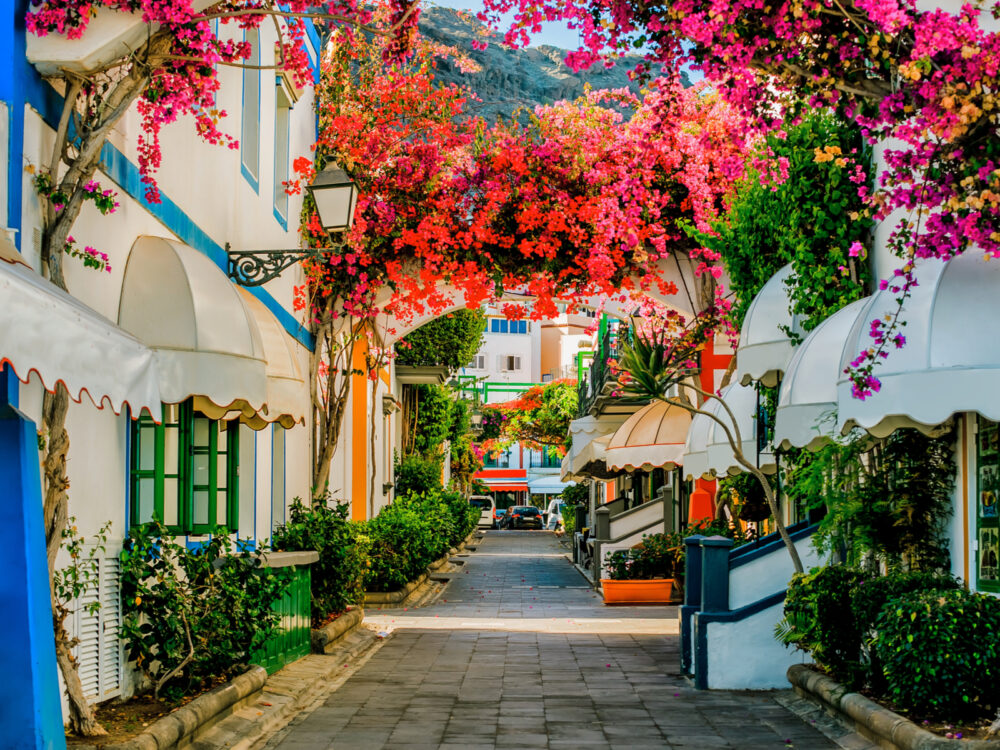
Natalishvets/Shutterstock
The least busy time to visit Spain is from April to May and (to a lesser extent) January to February. April and May are very quiet months in Spain, outside of Semana Santa on years where it occurs in April.
January and February are cooler, somewhat rainy months that are less popular for visits following the busy month of December. While there are pros and cons for all of these months, they can still be great for a visit if you want to avoid peak tourism crowds.
- January: 51-61°F; 3-12 rainy days
- February: 51-63°F; 3-10 rainy days
April and May see better weather than January and February — it’s warmer, drier, and better-suited for outdoor activities from beaches to national parks. But January and February offer cooler conditions for hiking and sightseeing.
The coasts in western, southern, and eastern Spain (like Barcelona, Vigo, and Málaga) are nice during the winter months with highs in upper 50s to low 60s. Inland and in the mountains, it’s cooler with some areas seeing snow in January and February.
In fact, the Spanish Pyrenees mountains along the French border see enough snow between December and February that it’s a popular area for winter sports like skiing and snowboarding. Check out resorts in the Pyrenees if you’re looking for cold-weather fun.
Vibrant Madrid (the capital) in central Spain is nice and quiet this time of year. Every district offers something different, so do some exploring. The Prado National Museum is perfect for a rainy day. Sightseeing around Plaza Manor and the Baroque-style Royal Palace is ideal between April and May.
Save time to visit Madrid’s Parque del Retiro on a sunny day to enjoy the lush greenery and colorful blooms as you stroll the winding lakeside pathways that lead to sculptures, elaborate fountains, and locals gathering for fun seasonal festivals.
In the foothills of the mountains in southern Spain, Granada offers something a bit different with its extensive Moorish history and architecture that seems more Moroccan than Spanish. The Alhambra sits high on a hilltop with palaces, gardens, and orchards to tour.
Eleventh-century Arab baths and white-washed Sacromonte Cave Houses are special spots to visit in Granada, while outdoor enthusiasts will want to go to Sierra Nevada National Park to hike scenic and rugged trails leading up to summits and deep into lush valleys.
The major downside to visiting during some less-busy months is the cost. January and February are the most expensive months of the year to visit Spain, but April and May are among the cheapest.
Here’s what we found when looking at pricing data from Google Hotels and Skyscanner:
- January: $430/night; flights from $317
- February: $428/night; flights from $321
January and February see the highest average prices on hotels, but April airfare is much more expensive than both these months. Still, the low average hotel prices in April (and May) make these two months incredibly affordable for a trip to Spain.
That’s why April and May are better months to visit than January and February, along with the drier and warmer conditions they experience across the country.
We’ve listed some of the best festivals and events taking place during April and May above in the Overall Best and Cheapest Time to Visit sections, but here’s what’s going on during January and February:
- Tamborrada (Jan) in coastal San Sebastian is a patron saint festival with a huge drum parade through the streets, beginning at midnight in mid-January with music, drum line processions, lots of food, and dancing in the streets
- Fiesta de la Candelaria (Feb) is a big deal in Madrid with pageants, parades, mock bull fights, traditional food, and music in this “Candlemas” celebration
- Carnaval (Feb/Mar) is celebrated ahead of Lent around Spain, with the biggest costumed parades of colorful floats and street festivals in places like Santa Cruz de Tenerife, Sitges, Barcelona, Madrid, and Águilas
September-October, December, and March are generally the busiest months in Spain for tourism. If you want to avoid crowds, coming between affordable, warm April and May or you can pay more to visit in cooler, wetter January and February.
Worst Time to Visit Spain
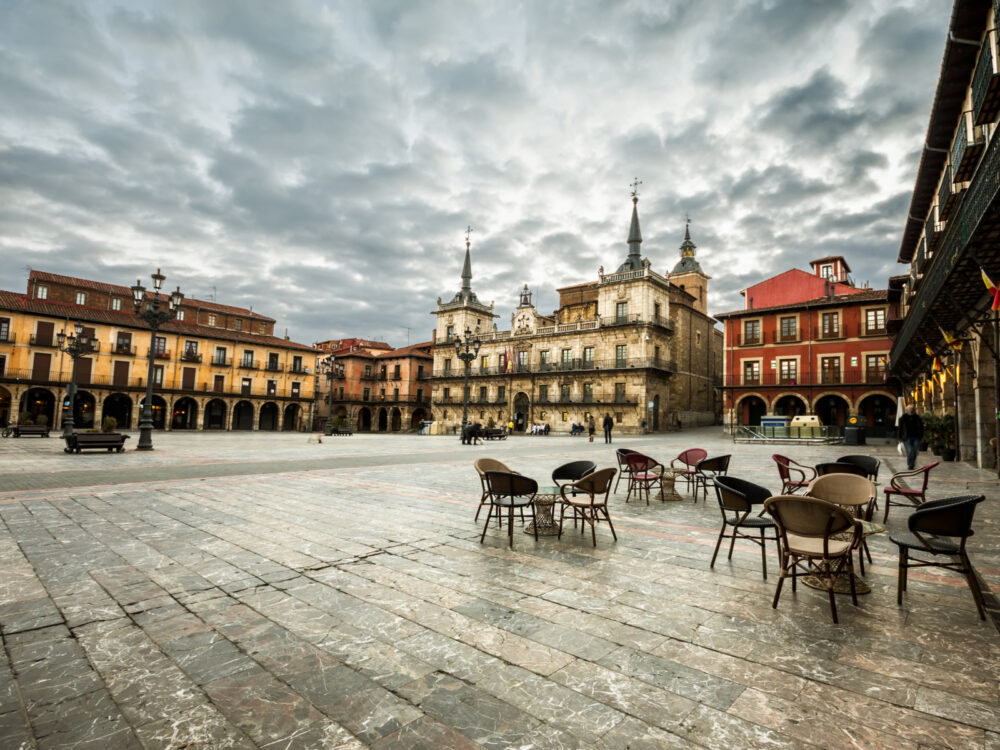
Marques/Shutterstock
The worst time to visit Spain is during July and August. These are the peak summer months with the most visitors, the highest average temperatures of the year, and bone-dry conditions that offer no relief from the heat.
East coast cities and islands, like Ibiza, Valencia, and Barcelona, are not only crowded, but also very humid this time of year, making it less enjoyable to spend time outdoors enjoying the sunshine or visiting restaurants, shops, and attractions.
- July: 75-91°F; 0-4 rainy days
- August: 76-90°F; 0-4 rainy days
Average daily highs rise to the upper 80s and 90s between July and August around Spain. While hanging out on beaches or at the pool can alleviate some of the discomfort, you’ll find it sticky and muggy when you want to explore the city or do some sightseeing.
While it’s a little too hot to enjoy the warmest cities, like Madrid and Granada, this time of year, it can be a fine time to visit Barcelona, Ibiza, Valencia, or Tenerife with the more-comfortable daily highs in the low-to-mid 80s (if you can deal with the humidity).
Mild Tenerife in the Canary Islands isn’t as humid as areas on the coast, so it makes a good choice for July/August if you don’t mind crowds. It’s one of the most popular times to visit here with the warmest weather for beaches.
Head to the northwest to visit Santiago de Compostela, a walled medieval city with some of the coolest historic architecture in the country. The Romanesque-style Santiago de Compostela Cathedral is the storied burial site of the apostle St. James.
July and August have another issue that make these months some of the worst for a Spain trip: the cost. July sees the highest airfare of the year. August is cheaper, but still not one of the cheapest months to visit.
- July: $206/night; flights from $500
- August: $219/night; flights from $341
Even though hotels are pretty cheap in July, you’ll pay dearly for your flight with round-trip airfare starting at $500 per person.
Even though it’s not the best time to visit Spain, you’ll still be able to appreciate some of the cultural festivals and events that happen during July and August, like:
- Pride Madrid (early Jul) is one of Europe’s biggest Pride celebrations featuring parades with floats, street parties, concerts, competitions, races, and food/drink in Madrid’s Chueca neighborhood
- Pamplona Running of the Bulls (Jul) brings a million-plus people to Pamplona for the famous tradition (since 1591) as people try to stay a step ahead of 12 bulls running from Corrales de Santo Domingo to the Plaza del Toros bullfight arena
- La Tomatina (Aug) in Buñol near Valencia is a big, town-wide tomato fight with truckloads of the juicy veggies being lobbed by locals and tourists alike in the streets
- Semana Grande (Aug) in Bilbao (northern Spain) is “Big Week” with a 9-day festival honoring Virgen de Begona with traditional dance and music, big parades featuring puppets, kid’s events, and folksy competitions
August is the better option between these two months, but it’s better to wait until September when flights and hotels are cheaper and temperatures settle into a more comfortable zone.
Spain by Month: What to Expect
The weather conditions, cost, crowds, and events that take place each month in Spain offer slightly different experiences month-to-month. Here’s what you can expect each month of the year (it’ll help you pick the best travel dates for you).
With cool weather and highs between the low 50s and 60s, quiet January is rainy in the northern and western regions with the most expensive hotel prices of the year (around $430/night). Flights cost upwards of $317 this month, but you can check out Tamborrada in San Sebastián.
February is another less busy month in Spain with highs between 51°F and 63°F (up to 10 rainy days). Hotels are expensive this month as tourism slows down, averaging $428/night with flights starting at $321. Events like Fiesta de la Candelaria in Madrid and Carnaval celebrations happen this month.
March starts to warm up with highs between 60°F and 66°F as rainfall slacks off a bit, making it a better month to visit Spain for sightseeing and beaches. Hotels average $399/night with flights as low as $330, so it’s not the cheapest month to visit. In Valencia, the weeklong Las Fallas honors San Jose with parades and paper mache ninots.
One of the cheapest and least busy months to visit Spain, April is a special month with highs from the 60s to about 70°F and 4-10 rainy days. With the lowest hotel prices (around $167/night), flights are costly at $463+, but you’ll still save by visiting this month. You may see Semana Santa celebrations and parades or visit the Feria de Abril in Seville.
May is one of the best months to visit Spain because it offers nice weather with highs from 65-75°F, 2-9 rainy days, cheap prices on hotels and flights, and plenty of cultural festivals to enjoy. Check out Madrid Day parades and fireworks, attend the Ibiza Medieval Festival, or go to the Fiesta de San Isidro in Madrid.
June is another of the best months to visit Spain with warm temperatures in the low 70s and mid-80s, almost no rain, and fair prices on hotels ($253/night average) and flights ($384+ round trip). Huge events and music festivals, including Primavera Sound and Sonar Festival in Barcelona and the messy Haro Wine Festival in Haro, happen this month.
July is a busy month for coastal and island destinations in Spain, but one of the worst for a visit because of the heat (up to 91°F highs), humidity, crowds, and high airfare ($500+ round trip). Still, events like the Granada International Festival of Music and Dance, Pride Madrid, and Pamplona Running of the Bulls are cool to check out this month.
Another of the worst months for a Spain trip, August sees average highs up to 90°F, crowded beaches and hotels, muggy humidity, and little rain to cool things off. It may be worth going to Buñol for the La Tomatina food fight festival or Semana Grande in Bilbao for cool puppet parades and folk music and dance.
As one of the best and cheapest months to visit Spain, September is nice with highs between 73°F and 82°F, 2-7 rainy days, and fair pricing on hotels and flights. This month, Barcelona celebrates with the Fiesta de la Merce over a 5-day period with city-wide parades and concerts.
Another of the best and cheapest months to visit Spain, October enjoys highs between a mild 67°F and 74°F with 5-11 rainy days. Hotels are cheap around $196/night on average with flights as low as $288 round trip. Head to Madrid to celebrate Spain’s National Day on the 12th with military parades, an airshow, and traditional food, music, and dance.
November can be a good time to visit Spain for cooler weather with highs in the upper 50s to upper 60s (warmer on the coasts). There are 4-12 rainy days with drier conditions in the south and cheap hotels around $161/night. Flights start at $307 and the Seveille European Film Festival happens this month.
Busy December is crowded but affordable with hotels averaging $158/night and flights from $288. With highs in the low 50s to low 60s, it’s cool enough for hiking and sightseeing without breaking a sweat. Christmas celebrations and events, including markets, parades, and light displays, make it a cool month to visit.
Frequently Asked Questions

RossHelen/Shutterstock
Still have a few questions about pinpointing the right months to visit Spain? Take a look at the most frequently asked questions and their answers below to learn more.
What is the best month to go to Spain?
April is the best month to go to Spain for a combination of small crowds, low prices, nice weather, and cultural events. September and October are also great months to visit, but see bigger crowds as some of the busiest months of the year.
What is the cheapest time to go to Spain?
April-May and September-October are the cheapest times to go to Spain. December is the cheapest month to visit overall with a 7-day trip costing as little as $1,394, but it’s a busy month with holiday festivals and events. Try April, May, September, or October for warmer weather.
What is the rainy season in Spain?
The rainy season in Spain runs from October to April/May, but the coastal areas and islands aren’t as affected by the rains. The northern and western regions of Spain see more rainfall, but even then, these places rarely see more than 2.4” of monthly rainfall.
What months is it hot in Spain?
It’s hot in Spain between June and September, but some areas are warmer than others. July and August are the hottest months with highs up to the mid-90s in the southern regions (like Seville and Granada). Islands like Tenerife and Ibiza are milder with highs in the 80s this time of year.
When to visit Barcelona, Spain?
The best time to visit Barcelona is between May and June or September and October, when the weather is warm (but not hot) and nice for beaches, sightseeing, and exploring the city’s many eateries, shops, and attractions. The city is also less crowded during these shoulder season months.
So, What’s the Best Time to Visit Spain?
The best time to visit Spain overall is during May-June or September-October for moderate crowds (May-June), mild-yet-warm temperatures, and great conditions for sightseeing, beaches, and outdoor recreation.
You’ll save money by visiting between April and May or September through December. Hotels are as low as $158/night and airfare starts at just $213 for round trip flights in May.
The best time to visit with smaller crowds is between January and February or (yep, again) April and May. April and May see fewer visitors overall, but January and February may be less crowded in coastal and island destinations.
Try to avoid visiting in July or August, which are the hottest, most humid, and most crowded months of the year across much of Spain. July also sees the highest airfare to Spain, starting at $500 for round trip flights.
Overall, Spain is definitely a year-round location where colorful traditions like flamenco dance and extravagant parades set a lively tone for your travels. With beaches, mountains, historic architecture, and great food to enjoy, you can’t go wrong when you visit during the best months of the year!
When to Go: Is Spain Safe to Visit in 2024? | Safety Concerns What to Do: The 16 Best Places to Visit in Spain (Our Picks for 2024) What It Costs: What a Trip to Spain Costs in 2024 | Average Prices
- Search Please fill out this field.
- Manage Your Subscription
- Give a Gift Subscription
- Newsletters
- Sweepstakes
- Travel Tips
The Best Time to Visit Spain for Great Weather and Famous Festivals
Start planning your trip to Spain now.
:max_bytes(150000):strip_icc():format(webp)/Stacey-Leasca-2000-631fabdcfe624115bea0ce8e25fdec96.jpg)
Rory Fuller/Travel + Leisure
Here's some good news for all of you out there wondering when the best time to visit Spain really is: any time is a good time.
Spain is a nation filled with history, a delightful food scene, and a varied landscape that's ideal for those looking for a city escape, a mountain getaway, or a beach adventure unlike any other. Ready for your ideal vacation? You can narrow down when to visit Spain by considering the following tourist seasons.
- High Season: June to August
- Shoulder Seasons: March to May and September to October
- Low Season: November to February
Here's everything you need to know about finding the best time to go to Spain based on the weather, your fellow tourists, and more.
Best Times to Visit Spain for Small Crowds
Spain is one of the world's most popular countries to visit, regularly drawing more than 70 million annual visitors before the pandemic. Many of these are northern Europeans seeking sunny escapes, so it's little surprise that Spain's busiest season is summer. Spain's attractions , beaches , and hotels swell with visitors at this time of year, meaning crowd-averse travelers should plan to visit at other times.
Winter in Spain — from November through February — is the best season for visitors hoping for smaller crowds. Many beach resorts close down for the winter months, but Spain's interior offers plenty of off-season treasures, from scenic cities and towns to under-the-radar ski resorts . If you want beach-friendly weather without peak-season crowds, try late spring or, especially, early fall, which lacks the mass appeal of summer as well as the spring-break and Easter holidays that draw millions to Spain in March and April.
Best Times to Visit Spain for Good Weather
Spain covers a large area and varied ecosystems, but according to the Spanish tourism bureau , no matter where or when you visit, you'll likely see at least some sun. "Spain is a sunny country with around 3,000 hours of sunshine every year," the bureau explains on its website. "The temperatures are mild, but there are still differences depending on the seasons and areas of the country."
Spring — from March to June — brings the country's most temperate weather. Again, Spain is sizable, but for the sake of this guide, we'll use Madrid as the basis for some stats. Early spring in the capital can be cool, with high temperatures around 60 degrees Fahrenheit, but by mid-June, temperatures reach into the 80s. April and May are rainier than some other times of year, but with an average monthly rainfall of just 1.3 inches, any showers should be manageable. If your goal is to avoid rain at all costs, though, July and August may be the months for you — they're the driest of the year in both Madrid and the country at large.
One place where the climate can vary significantly from the above is in the far-flung Canary Islands. This Spanish-held archipelago lies off Morocco's west coast, and it almost never sees temperatures below 60. Summer is arguably the nicest season in the Canaries, with cloudless skies and high temperatures usually in the upper 70s.
Best Times to Visit Spain for Lower Prices
Spain's most inexpensive season usually runs from December to March, which (not coincidentally) are the country's coldest months. If you don't mind forgoing balmy beaches, great deals can be found by traveling at this off-peak time — like a splurge-worthy stay in one of Madrid's best hotels .
You might want to avoid the weeks immediately surrounding Christmas, since they're a busy travel period for Spanish locals and other Europeans — but visiting in early December can give you access to Spain's lovely Christmas markets .
If you'd like an affordable trip with slightly warmer weather, try visiting in the fall. This shoulder season is less expensive than spring (though pricier than winter), and it's a great time to see the Spanish wine country , since harvest typically happens in September.
The Best Time to Visit Barcelona
With dazzling Gothic architecture, exciting events, and a lively waterfront, Barcelona is the top destination in Spain’s Catalonia region. Visit the city in early summer to hit the beaches before it gets too humid, or in the fall for sightseeing amid manageable crowds. June sees good weather and festivals like Nit de Sant Joan , Primavera Sound , Sónar , and El Grec Barcelona .
The Best Time to Visit Madrid
Head to Spain’s capital city in the spring or fall for the best weather and fewer crowds. In the springtime, Madrid holds celebrations like Dos de Mayo and the Fiesta de San Isidro . But the big event happens once the weather cools off a bit. The Autumn Festival (or Feria del Otoño) is a huge arts festival held in October or November each year, drawing acts from all over the world. Performances range from opera and ballet to theater and indie music.
Best Times to Visit Spain for Festivals
There's one more thing to consider when planning a trip to Spain: picking the coolest festival you can. The nation seems to have a celebration every day of the year, but some of its most famous festivals include Semana Santa or Holy Week (the week preceding Easter, typically in March or April); San Fermin (featuring the Pamplona Bull Run ) in July; and the Tomatina tomato fight , celebrated near Valencia each year on the last Wednesday in August. If events and festivals are your top priority, the Spanish tourism bureau publishes a yearly calendar that can help you pick your ideal dates.
Worst Times to Visit Spain
While there are fun festivals in the summer months and seasonal businesses are near-certain to be open, 100-degree days are becoming increasingly common . In some spots, like Madrid and the Balearic Islands, even the average temperatures can climb into the 90s.
Despite this, the season remains by far the busiest among tourists, primarily since Spain is such an easy getaway for Brits, Germans, and other Europeans whose schools are out for the summer. This high demand also drives prices to their annual peak, creating another good reason for the average visitor to try another season.
For the most favorable prices, crowds, and weather, time your trip for Spain's beautifully temperate spring.
Related Articles
The best time to go to Spain
Jul 10, 2023 • 4 min read
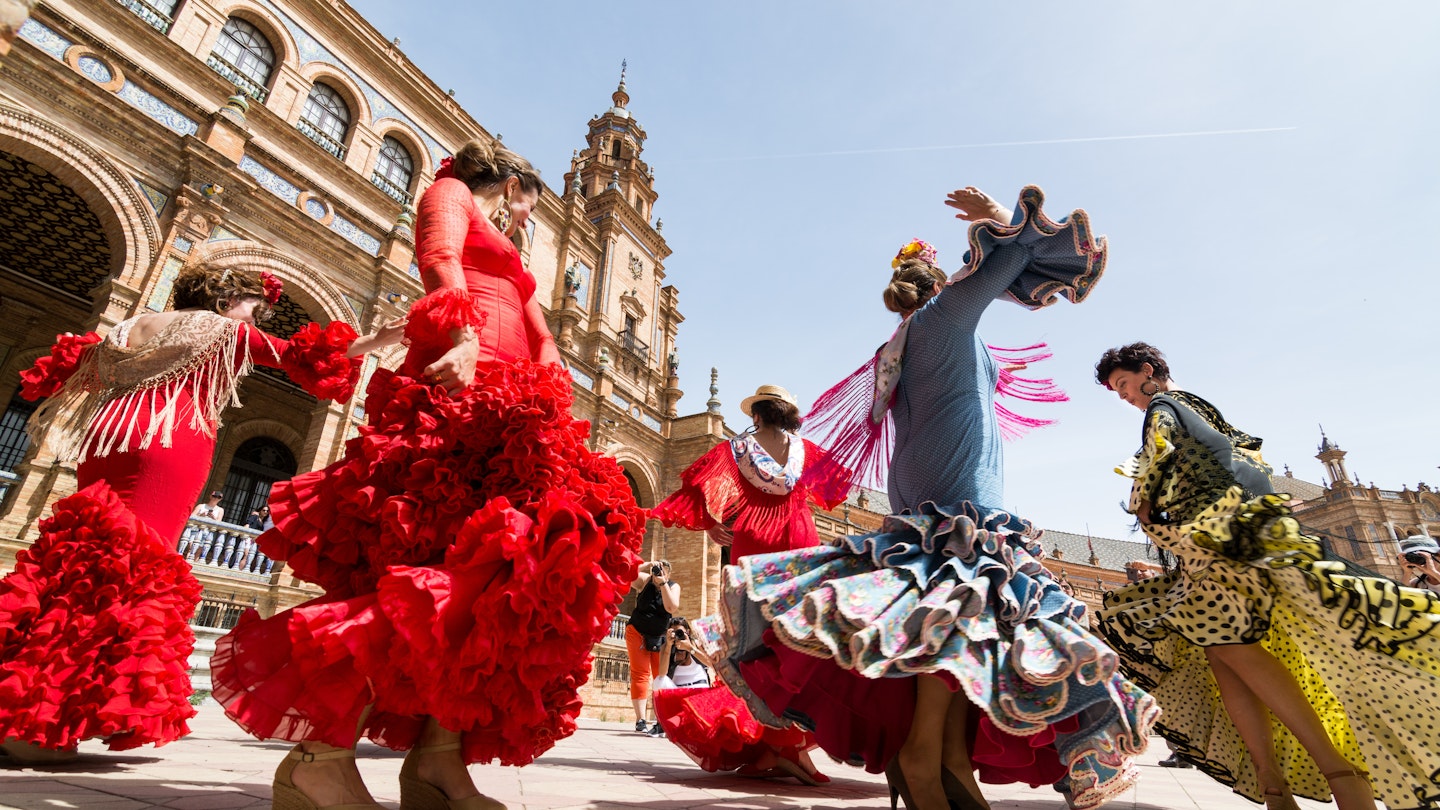
Season after season, Spain offers a rich and diverse range of experiences © leonov.o / Shutterstock
Spain consistently ranks as one of the most-visited destinations in the world for good reason. This vibrant and multifaceted European country has attractions that resonate with every kind of traveler.
Whether you’re a culture enthusiast seeking to immerse yourself in art and architecture , a sun worshipper looking for spectacular beaches and islands , a passionate gourmand embarking on a culinary tour or even a spiritual adventurer wishing to retrace the footsteps of pilgrims , Spain is one of those rare destinations that offers a rich and diverse range of experiences, season after season.
Consider what you’re looking for in a visit to Spain and plan ahead. Are you traveling on a shoestring budget? Looking for the best time to soak up the sun on a sandy coastline, or eager to feast in a harvest festival?
Here are some of the best times to visit this fascinating Iberian destination.
April to May and September to October are the best times for perfect weather
In central Spain and on the Mediterranean coast, the spring and autumn seasons are marked by sunlit days and pleasant weather perfect for strolling and outdoor dining in terrazas , with temperatures cooling down by nightfall.
Conversely, the summer months of July to August are scorching, with temperatures in central and southern Spain reaching the mid-to-high 40s°C. Madrid empties out in August , as locals go on summer holidays and many establishments close to avoid the oppressive heat. These summer months are ideal for visiting the northern regions , such as Asturias , País Vasco (Basque Country), Galicia and Cantabria , which have milder temperatures.

May to September is the best time to hit the beach
Spain is blessed with nearly 5000km (3107 miles) of coastline, stretching from the Atlantic Ocean to the Mediterranean Sea. Archipelagos in the Balearic Sea and off the northwestern African coast cap off the country’s maritime allure.
When the weather starts warming up in the wake of spring, Spanish beach destinations come to life, hitting their peak in August. Ibiza reaches its peak party atmosphere in July and August, when top DJs fly in to play in its world-famous clubs. If you wish to avoid crowded shorelines, opt for going in May and June.
April to May and September to October are the best times to walk the Camino de Santiago
The popular period for walking this thousand-year-old pilgrimage route towards Santiago de Compostela is between May and September, for favorable weather and longer daylight hours. To avoid those busy months, opt for the spring and autumn shoulder seasons when trails are less crowded, offering a more tranquil and introspective experience.
September to October is the best time for enjoying wine-harvest festivals
Oenophiles will particularly enjoy visiting Spain’s most famous wine-making regions, such as La Rioja and Ribera del Duero , during the traditional harvest season that starts in September. Logroño, the capital of La Rioja, kicks off its San Mateo festival, where you can take part in grape-crushing activities, parades and, of course, exquisite wine tasting for astoundingly low prices per copa .
For an off-the-tourist-radar experience, visit Valdepeñas in the Castilla-La Mancha region on the first week of September, when the entire town takes its love of vino to a whole new level with the annual harvest festival, featuring a wine tunnel and wine-tasting events in subterranean bodegas (wineries). There’s even a wine bus to take you home after a whole day of Dionysus worship.
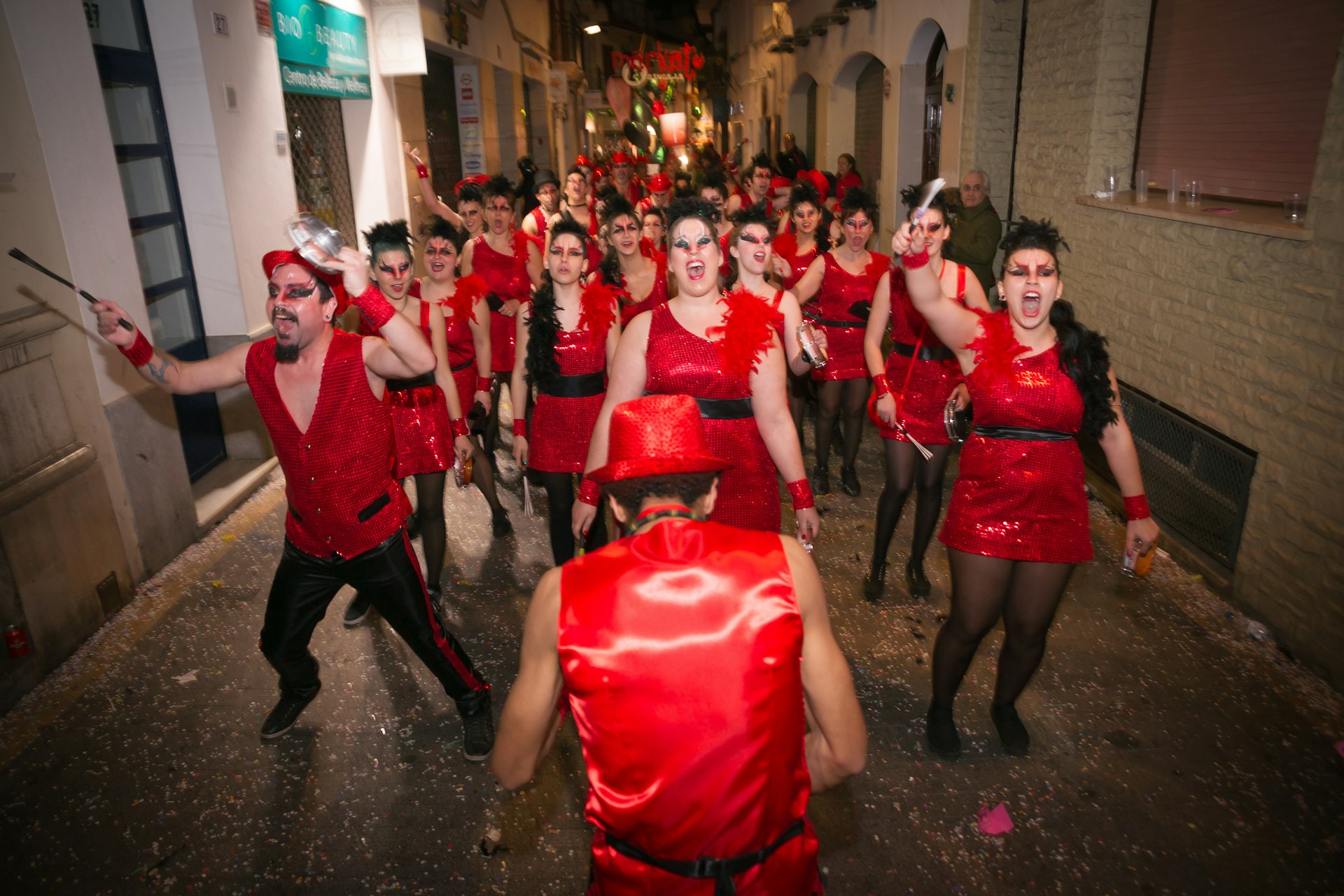
November to February is the best time for budget travelers
Spain’s winter season attracts fewer tourists, so prices are generally lower on accommodations and flights. Winter can actually be a great time to bundle up and visit Madrid and Barcelona , which come alive with Christmas lights, outdoor markets and holiday festivities.
November to January is the best time to indulge in olive-oil festivals
The annual olive harvest season is celebrated with olive-oil festivals all over the country, especially in the regions of Andalucía and Catalonia. Check out the gastronomic agenda for the Martos Olive Festival in the city of Jaen, which takes place annually on December 8, while the Siurana Olive Oil Fair happens every November.
January to February and July to August are the best times for sales shopping
Usually held after Christmas and the during summer holidays, when people have time to shop, the traditional rebajas (sales) periods in Spain is regulated by the Spanish government to protect consumers and local businesses. During these winter and summer sales seasons, bargain hunters can stretch their shopping budget, as stores use this time to clear their inventory and offer significant discounts reaching up to 70% off.
January to April is best time to try calçots
La Calçotada is a yearly gastronomic festival in the Catalonian region , where large groups gather to eat grilled calçots – a type of green onion harvested in the winter – dipped in delectable sauces.

January to March are the best times for skiing
Ski resorts usually open in December and close right after Easter in April. Peak snow conditions run from January to March in the Pyrenees and January to February in Central Spain. In southern Spain near Granada, the Sierra Nevada has a surprisingly longer ski season that can sometimes last until May.
This article was first published Apr 29, 2021 and updated Jul 10, 2023.
Explore related stories
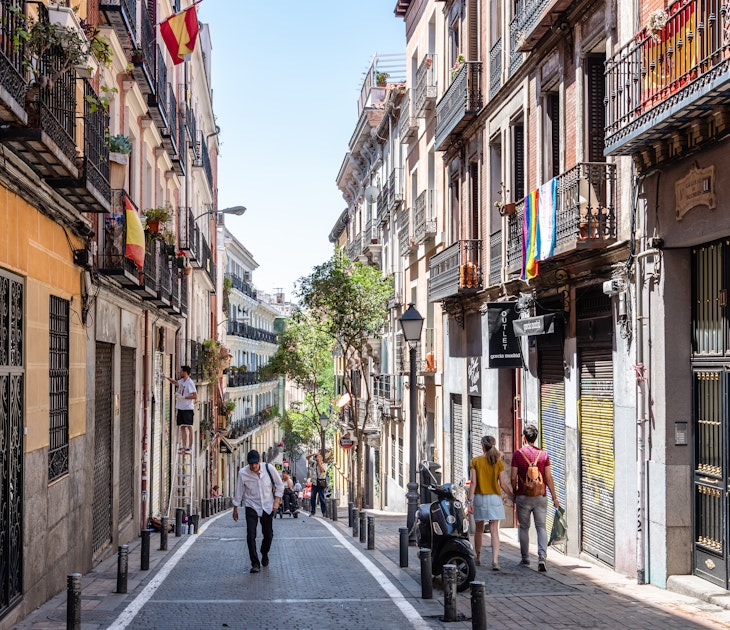
Tips & Advice
Apr 30, 2024 • 4 min read
You're excited about your imminent trip to Spain but what to pack? Don't worry, we've got all the insider tips and tricks you need to travel light.

Apr 19, 2024 • 10 min read

Mar 31, 2024 • 6 min read

Mar 26, 2024 • 8 min read

Mar 25, 2024 • 6 min read

Mar 21, 2024 • 6 min read

Mar 17, 2024 • 5 min read

Mar 13, 2024 • 7 min read

Mar 8, 2024 • 17 min read

Mar 2, 2024 • 7 min read


Best Time to Visit Spain: A Complete Guide
By: Author Hannah Cooper
Posted on Last updated: April 11, 2024

When is the best time to visit Spain? The answer isn’t as clear-cut as you might think.
Firstly, you’ll need to take into consideration how the weather and climate differ from region to region.
Spain is a huge country – it’s around about the same size as the state of Texas. It’s bounded by two coastlines: the Mediterranean Sea and the Atlantic Ocean. Each of these brings entirely different weather patterns.
A hinterland of mountains and low-altitude plateaus far from the sea also impacts the climate of Spain’s interior cities and regions.
Spain has two island archipelagos that are popular tourist destinations: the Canary Islands and the Balearic Islands. The Canaries in particular have a climate that varies from the mainland.
On top of the weather and climate conditions, you will want to consider how the peak vacation season might impact your experience. For many, July and August is the worst time to visit Spain due to the crowds and higher prices.
Furthermore – many travelers find southern Spain to be simply too hot (northern Spain is a whole other kettle of fish).
This guide will look at the best time to visit Barcelona, Madrid, Seville, Ibiza, and other popular Spanish destinations .
When is the best time to visit Spain for Weather?
Most regions of Spain experience hot, dry summers and dry winters. These vary from mild to moderate conditions based on where in the country you are.
Spring and fall are generally considered the best time of year to visit Spain for weather.
- Spring in Spain (March to May): The weather is pretty mild with temperatures rising the closer you get to summer. This is a great time for city sightseeing minus the intense heat and crowds of summer. Later in spring is delightful for cycling and hiking.
- Summer in Spain (June to August): All regions in Spain reach their maximum temperatures and the warm sea temperatures are lovely for beach vacations. However, the crowds and higher prices can be problematic in busy areas. Consider a non-typical beach destination or head into the mountains.
- Fall/autumn in Spain (September to November): Fall is another terrific time for agreeable weather and fewer crowds. Visit early in the fall for still-swimmable seas and hiking or plan a city break for a little later in the season.
- Winter in Spain (December to February): The southern coast experiences mild temperatures, while the interior and northern areas are chilly and cloudy. Winter is the best time to visit Spain for skiing.
Southern Spain receives the hottest summers and the mildest winters.
Northern Spain receives the most precipitation. All in all, the Atlantic coastline is also prone to cooler temperatures and mistier conditions.
There is a noticeable difference between daytime and nighttime temperatures in Spain at all times of year.
As part of your trip planning, consult our comprehensive month-by-month guides to the weather in Spain. These will help you nail down the best time to visit Spain for weather.
If you want to enjoy hot beach weather, the best time to visit Spain is in July and August.
When is the best time to visit Spain for the first time?
Leaving Spain with happy memories and a positive experience means you’ll be itching to plan your return journey. You’ll need to manage expectations before your first trip to Spain .
If you visit anywhere in Spain during summer, prepare yourself for crowds, lines, and higher prices. You’ll need to pre-book tickets and tours to avoid disappointment.
If you visit Spain during winter, you’ll enjoy calmer streets and cheaper hotel rates. However, you might encounter
Mid/late spring and fall tend to bring the loveliest weather conditions overall. However, these months are also when most parts of rain see the most rainfall. Also – be mindful that shoulder season is no longer a guarantee for avoiding the throngs.
Spain’s most popular cities and beach resorts are still pretty busy in late spring and early fall in particular.
At a glance, here is the best time to visit Spain for the first time:
- Best time to visit Spain’s beaches: June/early July/September
- Hottest time to visit Spain: July/August
- Quietest time to visit Spain: November/January
- Best time of year to visit Spain for hiking: May/September/October
- Best time to visit Spain’s cities: Consider winter for southern Spain when lines for museums are shorter. The northern cities are quieter in summer than the southern ones.
- Best time to visit Spain for weather: this depends on the type of weather you’d like.
Madrid is best during the shoulder season when it’s not too hot and not too crowded.
Best time to visit Barcelona
Barcelona is somewhere that you can visit in any month and have a great time. The Catalan city experiences mild winters, hot summers, and pleasant shoulder seasons.
July and August see the city become inundated. You’ll need to pre-book museum tickets, tours, and hotels. Early starts are advisable to spare the hot midday temperatures. However, the city is large enough to find a peaceful and shady spot to unwind.
Note that Barcelona receives most of its annual rainfall in the fall. October is the wettest month.
For the best weather and slightly quieter streets, the best time to visit Barcelona is May, June, or September.
Best time to visit Madrid
Madrid is located right in the center of Spain. Yet again, July and August are the hottest time to visit Spain’s capital city. Without a refreshing ocean breeze, it can get uncomfortably hot and dry at the height of summer.
As such, the best time to visit Madrid for warm weather is May, June, or September. You can dine al fresco at all of the best tapas bars in Madrid , explore the city parks, and enjoy the museums in the evenings after the sun goes down.
On the other hand, winter isn’t a bad shout at all. Prices are lower and it’s far more comfortable for seeing the staples of a Madrid itinerary .
Bilbao is wonderful in the spring and summer. It doesn’t get unbearably hot in northern Spain in summer, so it’s a pleasant time to explore the cities and enjoy the beaches.
Best time to visit Spain’s northern coast
Northern Spain refers to the region northwest of Madrid. This includes the Basque Country, Costa Verde, Cantabria, and Galicia. Cities include Bilbao, San Sebastian , Santander, Santiago de Compostela, and Oviedo .
July and August are the hottest time to visit Spain’s northern regions. Daytime temperatures bob around the early/mid 20s°C (70s°F) and the sea is warm enough for a dip.
As the northern coast isn’t as busy as elsewhere, you could certainly consider this region for a family beach vacation or as a hiking/cycling destination.
Winters do tend to be overcast, rainy, and chilly. If that’s not your cup of tea, stick to late spring or early summer. Otherwise, bundle up in your parka and explore the delights of Bilbao and the hugely overlooked Santander .
Best time to visit Spain’s Andalucia region
The autonomous region of Andalucia is one of Spain’s most popular regions in summer. Most cities and coastal resorts are flooded come July and August. The height of summer is the best time to visit Spain’s southern beaches for swimming although it’s still possible to go for a dip in the surrounding months.
The best time to visit Seville is any time but July and August.
Heatwaves can push the temperature to highs of 36-40°C (high 90s°F) and there’s no sea breeze to take the edge off. It’s also totally packed and you’ll end up in long lines to see all the top Seville attractions .
Winter is the best time of year to visit Seville. You’ll enjoy average temperatures of 16°C (61°F) and benefit from fewer crowds.
Córdoba and Granada are two other inland cities to consider in Andalucia outside of the peak summer months.
The seaside cities of Málaga and Marbella are also at their busiest in summer. These cities do benefit from an ocean environment but you’ll find that hotel prices spike. A lot of travelers are drawn to the lively atmosphere.
However, if you’re more preoccupied with ticking off the cultural things to do in Málaga than lounging in the beach clubs of Marbella , you’ll love visiting this area in mid-spring, fall, or even winter.
Cádiz is an Andalucian port city with an Atlantic Ocean coastline. This city has an incredible history and is slightly quieter than the Costa del Sol in summer. However, it’s preferable to visit Cádiz in May, June, or September for a more pleasant experience overall.
Alicante is a beautiful part of Spain and is often touted as one of the best places in winter. I enjoyed visiting during the spring when it was warm enough to spend most of the day outside.
Best time to visit Valencia and Alicante
Valencia sits just up the coast from Andalucia and bridges the gap between the southern region and Catalonia.
The cities of Valencia and Alicante are very popular in summer although they are a calmer alternative to the Costa del Sol. You’ll find a good mix of culture and beaches in Valencia while Alicante is ideal for a small-city vibe near beaches.
The best time of year to go to Spain’s Valencia region is June, directly before the summer rush, or September at the tail-end of high season.
Again, consider winter for a quieter experience that’s a little warmer than Barcelona and the Costa Brava.
Best time to visit Almería
Almería is unique as it has a desert climate. The city gets extremely hot during July, August, and September and this makes it too hot to visit the Tabernas Desert.
May is the best month to visit Spain’s desert region before it gets too hot. It’s also the prime time for visiting the incredible Cabo de Gata Níjar Natural Park . As Almería stays mild all winter, you should also consider this hidden gem for a winter sun getaway.
The city is hushed from late fall through to early spring so you’ll enjoy having the Alcazaba practically to yourself and peaceful walks along the local beaches.
Beaches in Spain are wonderful all year long. You can head south to the Costa del Sol or Almeria as early as May and still enjoy sunbathing.
Best time to visit Ibiza
The best time of year to go to Spain’s party island for clubbing is summer. The super clubs gradually reopen from the start of June and close for winter in October.
A couple will have soft launches in May – this is a nice month to visit for warm weather and minimal crowds. There are still bars where you can let your hair down and enjoy a cocktail although you’ll certainly get your beauty sleep.
Ibiza experiences mild winters with lows of 48ºF (9ºC) and highs of 62.5ºF (17ºC). Wind can make it feel chillier, especially on overcast days. The island is very quiet during these months and prices are significantly lower on this expensive tourist island.
You’ll find slightly fewer things to do in Ibiza in winter but it’s a nice option for a yoga retreat or bit of me time.
Best time to visit the Canary Islands
As the Canary Islands are located closer to the African continent than the Spanish mainland, they experience a different climate to southern Spain and the Balearic Islands.
The islands are hot and dry during summer but mild all winter. In fact, the Canary Islands are one of the warmest places in Spain in winter .
As such, it’s one of the most popular destinations for British and Northern European holidaymakers seeking winter sun and there does tend to be a peak in numbers during December around Christmas.
Still, July and August remain the busiest months overall. June and September are ideal times to visit the main islands of Tenerife, Gran Canaria, and Lanzarote for hot weather and a quieter environment.
Surfing is a year-round activity but winter is better for competent surfers and summer has gentler conditions.
Explore the coast in Spain in spring and autumn to get the best weather and avoid the huge summer crowds.
Final thoughts on the best month to go to Spain
In conclusion, the best month to visit Spain is dependent on the destination you have in mind and the type of experience you are seeking.
July and August are the hottest time to visit Spain across the board. Many people prefer to visit outside these months as the crowds can dampen the experience. However – others thrive off the lively environment and mingling with other travelers.
In general, the best time to visit Spain for the first time is May, early June, or September. This way, you escape the boiling temperatures and crowds but can still enjoy the sunshine and warm weather.
These months are also ideal for hiking, exploring open-air historical sites, cycling, and swimming in the sea.
Winter is not a bad time to consider a trip to Spain. The southern regions remain warm and sunny while the northern coast will still feel warmer than parts of Northern Europe and the United States.
Do also consider the various festivals in Spain . Some of these are fun to attend as a tourist, others see the local area closed down temporarily or may cause issues with booking transport and hotels.
Weather & Climate
Top Destinations
Getting Around Spain
One-Week Itinerary
Top Things to Do
Top Attractions in Each City
Best Beaches
Events and Festivals
UNESCO World Heritage Sites
Food to Try
Drinking in Spain
Best Time to Visit
The Best Time to Visit Spain
Jamie Hergenrader is the Commerce Director of the Travel Group at Dotdash Meredith where she leads the content strategy of product reviews and recommendations for the company's travel brands. She joined the company in 2018 and has nearly a decade of experience writing and editing for travel and lifestyle publications.
The best time to visit Spain is typically in the spring (March to May) or during the fall (September to November ). At these times, you'll likely find fewer crowds, cheaper accommodations, and the best weather (even for hitting the beach!).
Whenever you decide to go, use this guide to help plan your trip to this country known for its rich culture, pristine beaches, delicious food, and endless things to do.
Popular Events and Festivals
Spain has events throughout the year that attract visitors from all around the world, especially during spring and summer. If you plan on traveling to attend one of these, get an early start on booking accommodations, which fill up quickly. If you're not trying to attend these events, go elsewhere in the country when they're happening or wait to travel at a different time to avoid dealing with the crowds and high prices in these areas. See a more complete list of events by month below.
Spain also has national public holidays and regional ones. Take particular note of holidays that fall on a Thursday or Tuesday, as the Spanish tend to take the Monday or Friday between this holiday and the weekend off work (this is called a 'puente' or 'bridge'). You may find a lot of things closed during these extended weekends.
The Weather in Spain
Temperatures in Spain typically don't dip too low, even in winter when the lows hover in the 40- to 50-degrees F range country-wide. But summers, on the other hand, can get really hot, with highs creeping into the low to mid-90s in some places.
For this reason, it can actually be best to visit the beaches during the shoulder seasons in late spring/early summer (May or early June) or late summer (August to September, even October) to avoid the extreme heat. While temperatures are a little more unpredictable during these times (be prepared for the occasional rain shower), average temps still go up to the high 70s or low 80s, making them an ideal time for beach days and also days to sightsee and explore the cities as well.
If the hot summer months of July and August are the only time you can travel, consider visiting the north of Spain where temps don't soar quite as high (highs reaching upper 70s in the summer), such as Bilbao and Santiago de Compostela .
Peak Season in Spain
For tourism, peak season is typically during the summer months, particularly July and August, and that's evident from the higher prices for hotels, possibly flights, and other accommodations in the cities. So if you're looking to travel at this time, book on the earlier side to avoid paying whatever higher prices are left as it gets closer.
And just because it's peak season for tourists, that doesn't necessarily mean it's overwhelmingly crowded. A lot of locals, especially people from the inland cities, actually leave the country or head to the coast to escape the heat. However, this also means that many local businesses in the same towns might be shut down temporarily to give their employees vacation.
This is still off-season for Spain, so crowds should be relatively minimal and hotels and other accommodations are usually cheaper.
Events to check out:
- January begins with Three Kings Day celebrations on the 6th, followed by a number of interesting celebrations in the Balearic Islands.
- The San Sebastian festival in the city of the same name, with its Tamborrada drumming, is the biggest event of the month.
Weather around the country is still pretty chilly, especially in Madrid and the northern parts of Spain, such as Galicia and Bilbao where temperatures stay in the 40s to 50s. It's also the rainy season for this area, with rain every day or every other. Barcelona is less wet but has comparable temperatures to northern cities. Andalusia is the warmest with days reaching highs in the mid-60s.
- February is carnival month, a celebration to mark the start of Lent, with the biggest events appearing in Cadiz and the Canary Islands.
- The Festival de Jerez , one of the most prominent flamenco festivals in the country, happens in the city of Jerez.
You might get some warm weather in Andalusia, you might not, but it's worth packing sunblock and something to keep the chill out, just in case.
- In March, Valencia is home to Las Fallas , a weeklong event mostly known for its giant, crafted figurines that are paraded through town and then set on fire.
- Semana Santa , a.k.a Holy Week, is a religious celebration with processions in the streets put on by local brotherhoods. It takes place throughout several cities in Spain during Easter, lasting about a week or longer depending on the location.
- Sant Medir festival : During March in Barcelona , horses, carriages, trucks and more wind their way through the streets of the Gracia neighborhood, throwing candy and other sweet treats to the eager spectators lining the sides of the roads.
The whole country is slowly warming up, but the weather could be quite unpredictable wherever you are. April should see some warm weather in Andalusia, and sunbathing might be possible, but nothing is guaranteed at this time of year. Because the weather is decent (but still might not be suitable for the beach yet), schools are still in session, and it's not yet peak season for tourists, this is a good time to check out local attractions in whatever city you're visiting, such as museums, cultural centers, cathedrals, etc. that might be more crowded in later months.
- The Feria de Abril, the spring fair that celebrates the people and traditions of Seville, typically happens in April, as it is held two weeks after Easter.
- Madrid hosts the Festimad music festival , featuring nightly concerts of a variety of music.
Hot in the south and warm in much of the rest of the country, though Madrid can remain changeable throughout May and the north and north-west can still expect some cool days.
- There are a number of local festivals in Spain in May, usually celebrating each area's local traditions and customs, including the Festival de San Isidro in Madrid and the Feria de Patios and Feria de las Cruces in Cordoba.
- Madrid hosts the Madrid Open, the country's largest tennis tournament.
- Lleida is home to the Aplec del Caragol , where 12 tons of snails are eaten in this culinary festival.
June is much more reliable weather-wise, with glorious sunshine and warm weather in most of the country. As the weather starts to warm up, though, some local businesses might start to shut down to take their own vacation in the summer. However, major tourist attractions and museums are typically open year-round, with the exception of major holidays in some cases.
- Granada hosts the Water and Ham festival , which is basically just a gigantic water fight.
- Madrid hosts PHoto España , the city's largest photo exhibition.
The weather is hot, hot, hot! Central locations like Seville and Madrid are ghost towns, as the locals migrate to the coast to cool off in the sea.
- San Fermin , more commonly known by one of its events, the running of the bulls, happens every year in Pamplona from July 6th to July 14th.
- Horse racing on the beach at Sanlucar de Barrameda is also a popular event this month.
It's still very hot this month, especially in the inland cities, so some local restaurants and businesses might still be closed in those places.
- Another well-known event, Tomatina , is a festival where thousands of people throw tomatoes at each other. This happens on the last Wednesday of August in the town of Buñol.
- Feria de Malaga, perhaps Andalusia's biggest summer festival, includes concerts, dancing, great food, and more.
- The Basque region also holds a large festival, Semana Grande, in Bilbao and San Sebastian, that's packed with events like fireworks, bullfighting, and more.
It can still be quite warm in September (and far more bearable than in August) but the later you get the more unreliable the weather is likely to be.
- Festa de la Mercé happens in Barcelona, one of the city's biggest festivals of the year that celebrates the city's patron saint with wine fairs, fireworks, and other events.
- San Sebastian also hosts one of the world's largest film festivals at this time.
- The region of La Rioja , Spain's famous wine region, holds its grape harvest celebration.
The weather gets steadily cooler during the end of September and into October, but weather-wise, this is one of the best time to visit central cities such as Madrid and Salamanca that are usually unbearably hot in summer and also some of the coldest in the winter.
- Catch the Bienal de Flamenco, Spain's biggest flamenco festival, held every two years.
- The Week of Architecture celebration has exhibits, children's workshops, and events held in Madrid's most famous buildings.
- Tarragona hosts an annual "human castle building" competition, where large teams of people transform themselves into castles by stacking high on top of each other.
Matters wind down in November as the country gets ready for Christmas, but there are still events this month worth noting. This time of the year is when fall turns to winter and the weather will change accordingly. Sunny and chilly in the south; just chilly (mid-40s to 60s) in the rest of the country.
- Jazz fans will enjoy the festivals in Madrid , Granada , and Barcelona this month.
- There are several beverage tastings held across the country, such as International Sherry Week in Jerez, Feast of the Orujo in Potes, and the San Andres Festival on the island of Tenerife.
- Several film festivals are held around the country including Madrid —see a full list here .
Smaller cities and towns might be more low-key or mostly shut down during the holidays. And Christmas Day itself, you're unlikely to find many restaurants or bars open at all, as this is a family holiday. Weather is still getting colder with the inland cities (typically the coldest) only reaching the low 50s during the day. You might see some snow in December, but that's more likely in January or February.
- December is dominated by Christmas and the many events associated with it, several local events per week, especially in Madrid and Barcelona.
Spring and fall are the best time to visit Spain for good weather, travel deals, and minimal crowds. May to mid-June and September to October are some of the best months for traveling around Spain.
The period between Christmas break and Easter is the low season for travel to Spain, typically from January to March. The weather is cold, but not frigid, so if you don't mind bundling up it's a great time for finding the best deals.
The peak season for tourism is summer, especially from mid-June to early September. Apart from being the busiest time in the country, the weather can also be brutally hot. Visit at the end of spring or early fall for milder temperatures and fewer crowds.
The Local. "Spanish Word of the Day: 'Puente.'" Retrieved February 1, 2021.
Weather and Climate. "Climate and average weather in Spain." Retrieved February 1, 2021.
August in Spain: Weather, What to Pack, and What to See
Where to See a Bullfight in Malaga, Ronda, or the Costa del Sol
Top 15 Events in Spain in August
How to Get from City to City in Spain
Plan the Perfect Trip to Spain
The Best Time to Visit the Dominican Republic
The Very Best of Spain's Cities, Regions, Food, and Drinks
The Best Time to Visit Dubai
The Best Time to Visit Japan
The Best Time to Visit Boston
Best Cities to Visit in Spain in November
The Best Time to Visit France
The Best Time to Visit the Bahamas
Festivals, Events, and Things to Do in Spain in October
October in Europe: Weather, What to Pack, and What to See
October in Spain: Weather, What to Pack, and What to See
Change location
- UK / International
- Call toll-free from 9am EDT
- 617-223-4521 617-223-4767 or
- REQUEST A QUOTE

When is the best time to visit Spain?
- Month-by-month
There isn’t one best time to visit Spain, because the country’s diverse offerings mean you can find something to enjoy at any time of year. Many people opt to travel there in late spring (April-May) or early fall (September-October).
Spain has a relatively mild climate, staying mostly dry year-round. Winter temperatures rarely drop below 50°F. Summer can be quite hot, especially in the south, and sees a greater influx of European visitors heading to popular beach resorts.
While it can get cold and wet in the north during the winter, the south remains very pleasant. Temperatures in the north make it a great option during the summer if you are worried about the heat.
- Make an inquiry
- Request a brochure
Month-by-month guide for traveling in Spain
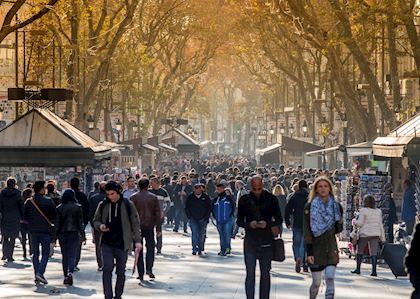
Visiting Spain in January - February
The beginning of the year can be rather quiet in Spain, with thinner crowds and less activity, though most businesses are still open. This time of year, especially January, is known as ‘rebajas’ season, when items at most stores are heavily discounted after Christmas, offering great deals.
Events & Festivals
- Three Kings’ Day (January 6): Spaniards celebrate the Feast of the Epiphany, or Three Kings’ Day, with street parades where public figures dressed as the Three Wise Men throw treats to the children.
- Carnival (February): Leading up to Lent, Spain’s carnival sees some Spaniards celebrating with large parties involving lots of sangria and outlandish clothing.

Visiting Spain in March - April
As the weather starts to warm up, the streets of Spain begin to buzz with more activity, though they aren’t as crowded as the summer months. Many people venture out for Semana Santa, Holy Week, to watch the parades that take to the streets. The warmer, but not overly hot, temperatures make it a very pleasant time to visit.
- Semana Santa (March/April): Holy Week is celebrated with parishes joining together throughout the week for elaborate parades featuring glittering statues carried by hooded men.
- Festival de Jerez (March): Over a couple of weeks, people flock to Jerez for one of Spain’s largest celebrations of flamenco music and dance, to learn from masters as well as watch some of the best dancers in the business perform.
- Feria de Abril (starts two weeks after Easter in April/May): Seville hosts its annual fair, filled with carnival rides, dancing, along with plenty of food and drink. Men traditionally sport a traje corto (long tight pants and a short jacket), while women don flamenco garb.

Visiting Spain in May
Temperatures continue to rise in May, when the country comes alive with vibrant flowers and locals begin spending more time outside in the sunshine. May is a great time for outdoor activities such as hiking or heading to the beaches before they’re overrun with visitors. Temperatures are warm and tend not to have reached the uncomfortable levels of high summer.
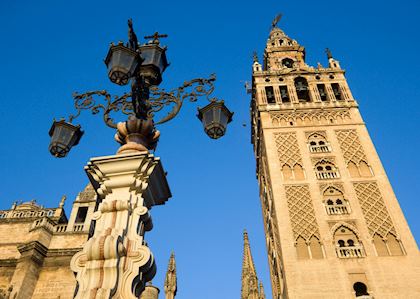
Visiting Spain in June - August
The summer months can be hot and crowded and, like many other Europeans, Spaniards will flock to the coast to enjoy cooler weather and relax on the beach. Despite the heat, this time of year shouldn’t be avoided altogether. Buoyed by the longer days, Spaniards look for ways to unwind at night, so these months see a greater number of lively festivals and more evening revelry. Many festivities surround Spain’s food and wine and can be a real highlight of the summer.
- Batalla del Vino, or ‘Battle of Wine’ (June 29): In a lighthearted ‘battle’, locals in La Rioja douse each other with the province’s red wine.
- International Festival of Music and Dance (June/July): Granada hosts one of Spain’s largest and most important arts festivals, dedicated primarily to flamenco but showcasing other forms of music and dance, with several events taking place against the backdrop of the Alhambra.

Visiting Spain in September - October
Spain begins to quieten down after the rush and crowds of the summer. Temperatures return to pleasanter levels and most visitors have gone home, leaving the country in a more peaceful state, though still vibrant with daily Spanish life. Taking advantage of the pleasant weather and smaller crowds, this is a recommended time for exploring the country.
- Bienal de Flamenco (September): Held every other year in Seville, this festival is one of Spain’s largest and most important celebrations of flamenco and attracts professional performers from all over the country.
- Fiestas de San Mateo (September): A week of parades and concerts in La Rioja as the Feast of Saint Matthew coincides with the grape harvest.
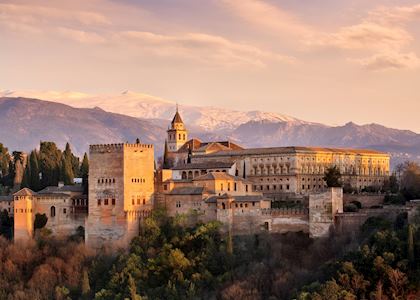
Visiting Spain in November - December
Spain becomes cool again as winter approaches, but there is still plenty to enjoy. In November, jazz festivals are held in many major cities while in December, Spain’s streets are decorated for Christmas.
Spain Climate Guide
Why travel with audley.
- 100% tailor-made tours
- Fully protected travel
- Established for over 25 years
- 98% of our clients would recommend us

Travel advice
Practical tips for traveling to Spain, from social protocols to guidance on money matters, with a link to the latest US State Department travel advice.

Request our brochure
Covering all seven continents, The World Your Way shows you how you can see the world with us. It features trip ideas from our specialists alongside hand-picked stays and experiences, and introduces our approach to creating meaningful travel experiences.
Trip ideas and travel guides for exploring Spain

Best of Barcelona & Madrid
7 days from $6,895pp
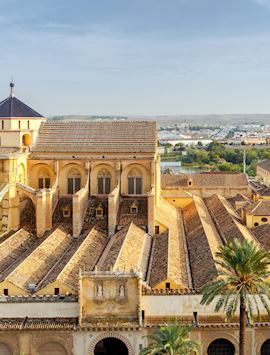
Southern Spain explored
10 days from $8,490pp

The taste of Spain: a Spanish food guide
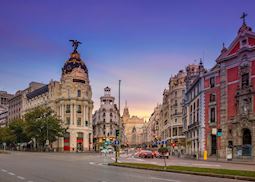
In and around Madrid: our highlights
These are the best times to visit Spain

Feel like indulging in flamenco, tapas and vino? A trip to Spain may just be in order.
There's really never a bad time to visit the country. But depending on what style of vacation you'd like to have -- steamy summer nights along the Costa del Sol, partaking in traditional celebrations like a massive tomato fight or seeing all the major tourist attractions and historic monuments during a quieter, less touristy season -- you'll want to visit the country at different times. Budget also can be a concern, so traveling when you can find the best flight deals, award availability or hotel prices might play a factor in when you decide to visit.

I've lived in Madrid , Spain for 12 years now, giving me the opportunity to lap the country from top to bottom time and time again. From numerous visits to all the most typical tourist attractions like Granada's Alhambra palace, Ibiza's beaches or Barcelona's Sagrada Familia to more off-the-beaten-path itineraries, like jumping over beach bonfires during Alicante's San Juan festival or road-tripping through tiny villages in under-the-radar regions like Asturias or Extremadura, I've been lucky enough to experience various regions of Spain at all different times of the year.
Taking into account my travel experiences as well as flight and hotel statistics and data, these are best times to visit Spain, whether you're motivated by cost, weather, crowds or events.
For more TPG news delivered each morning to your inbox, sign up for our daily newsletter .
The cheapest time to visit Spain
According to data from Expedia, the cheapest months to fly to Madrid are November and February. When it comes to lodging, January and February are when the most affordable hotel rooms are available. (August also has affordable room rates, likely because most European travelers have beelined for the beach as opposed to the city.)

If it's Barcelona you'd like to visit, the best airfare deals can be found in January, October and March and the cheapest hotel deals can be found in January.
Those hoping to head south to Seville should fly in February, September or January for the best rates. January, as well as the ultrahot months of July and August, are when you'll find budget hotel prices in Seville.
If it's Iberia award availability you're after, keep in mind that the calendar is connected to peak and off-peak dates for Spanish travelers, which may just benefit you if you're adhering to U.S. holiday and school schedules.
For example, in 2020, all of March, much of May and the first half of June is considered off-peak for Iberia, as is the second half of September, the second half of October and almost all of November (Thanksgiving is off-peak too, and we highly recommend avoiding all the holiday hoopla in the States and jetting off to Europe instead ).
Best seasons to travel to Spain
Deciding when to visit Spain, especially if you aren't motivated by price, is best done by factoring in exactly what you'd like to do. Vacations oriented to beach time, wine tourism, hiking or city breaks each come with their own best time to visit.
Best time to visit Spain's most popular cities and regions
Best time to visit Madrid
Madrid's summer temperatures can rise to over 100°F in the summer, so it may be best to avoid the city during this time if you hate being hot. If you do visit, you might find the city practically void of locals -- everyone is at the beach, and Spanish often tend to spend a quincena (a two-week period) or even a full month on vacation each summer (but that leads to those cheaper August hotel room rates). Visitors in the shoulder seasons such as May and October often see perfect, mild weather, and May has some of Madrid's best local festivals. A trip in late November and early December may be rainy/chilly, but will get you in the holiday spirit, as there are a few Christmas markets around the city and the center is heavily decorated and full of holiday cheer.

Best time to visit Barcelona
One of Barcelona's greatest attractions is its Barceloneta beach, which can get very crowded in the summer. It's best to visit on the edge of the shoulder seasons like end of April/beginning of May or the end of September/beginning of October if you want to enjoy mild beach weather (hopefully) with fewer crowds. However, Barcelona is a city struggling with overtourism, so if you'd prefer to see the sites crowd-free and don't mind chilly weather, January, February and November are likely the best times to visit.

Best time to visit Andalusia
Southern Spain has some of the most picturesque attractions in the country. It's best to avoid visiting this area between June and August, when temperatures soar, and Holy Week, when accommodation costs skyrocket as visitors crowd cities like Seville and Granada. May typically has some wonderful festivals (more on that below) which may bring in Spanish travelers but not as many foreign tourists, making it ideal for travelers looking to get in on some local culture. March and November often still see warmth and sunshine and fewer visitors in general.
Best time to visit Spain's beaches
Summer is when all of Spain (and all of Europe) descends on the Spanish coast. If you don't mind sharing the sands umbrella-to-umbrella, visiting the beach in Spain in summer is loads of fun, with nonstop parties and events. It's definitely not a quiet getaway, so if you'd prefer to have the beach to yourself, May, June and September are better times to visit many of the coastal regions for lower prices and fewer crowds. Beware that Atlantic beaches, like Cádiz, will have much colder waters than the Mediterranean, especially during the spring and fall seasons.
If you're looking to avoid heat entirely but want to travel in the summer, northern beaches in spots like Asturias, Galicia and Cantabria often see much cooler temperatures in the summer. Surfers (including kite and windsurfers) should plan to hit spots like Tarifa in spring or fall, when winds and swells are optimal.

Best time to visit Spain's wineries
Without a doubt, autumn is the best time to visit Spain's wine regions (there are several, though Rioja and Ribera are some of the most famous), to enjoy harvest festivals, wine tastings, and of course, see the region's beautiful vineyards and foliage changing color. However, wine tasting can be done year-round, and many wineries are in proximity to Spain's largest cities. You can take make a day trip out of a wine tour/tasting from Madrid, a cava tour/tasting from Barcelona (the Allela region) or even a sherry tour/tasting from Seville at any time of year.

Best time to do the Camino de Santiago pilgrimage
The famous Camino trail (in part or full) becomes very crowded in July and August. Holy Week in Spain (ending on Easter Sunday) is also a popular time to do portions of the walk. The best time to do this pilgrimage while avoiding crowed trails but also still having decent weather (minimal rain and mild temps) is in May, June or September.
When to visit Ibiza, Mallorca and the Balearic islands
The weather on the Balearic islands is best between April and October -- warm and sunny. Of course, these are also the months that are the most crowded. But if you visit outside of these months, especially spots like Ibiza, Formentera or Menorca, many hotels/restaurants/nightclubs are closed.

It may best to visit these island destinations in May/June and September/October to get fewer crowds (July and August are packed) but also nice weather. If you're looking to beat the crowds in Ibiza, avoid "opening" and "closing" weekends for the official vacation season, which often draw many European tourists.
When to visit the Canary Islands
The Canary Islands have sunny, spring-ish weather year-round. Many areas of the seven islands remain tourist-free even during the busiest times of the year, which can be Carnaval in March, or summer, when many Spanish and European tourists descend on the island.
When to visit Spain for events and festivals
February/March bring many Carnaval celebrations all over the country, but Cádiz and the Canary Islands see some of the most exciting celebrations, including costumes, contests, musical acts and parades.
Las Fallas occurs yearly in March in Valencia. Teams spend months building giant, elaborate wooden structures in the form of characters or objects, then spend five days in March burning them down to the awe and delight of both tourists and residents.

Holy Week, which culminates in Easter Sunday, is celebrated throughout the country. Holy Thursday and Good Friday are official holidays, and religious processions are held in many Spanish regions but are most famous in southern Spain. Unless you really want to view these cultural events or are very religious, it may be best to avoid southern Spain, especially Seville, around Easter due to massive crowds and expensive hotel rates.
Spring is big for festivals in Seville, as the Feria de Sevilla is held yearly in April/May. Expect wild parties all week long at the fairgrounds, but the best casetas , or private tents, are only accessible if you know someone -- this festival is a big deal for local residents.

May is one of the best months for festivals in Spain. Madrid's San Isidro has festival grounds, parades, and musical events all around the city -- and locals are out and about all week long partaking in the fun, which is open to everyone. Meanwhile, down south, Córdoba's patio festival runs for two weeks, featuring special routes allowing visitors to admire the famous (and mainly privately-owned) courtyards and patios covered in colorful flowers that residents carefully tend all year long. You can even vote for your favorites.

June sees the famous wine figh t in Haro, so if you've ever dreamed of dousing fellow festivalgoers with a supersoaker filled with wine, or getting drenched with wine blasted out of fire hoses, this is your chance. Wear white and prepare to be covered in purple almost immediately.

The end of June sees Alicante's San Juan festival, where, in similar fashion to Las Fallas, large wooden structures are burned starting at midnight. Locals love to spend the entire night jumping over beach bonfires.

Madrid's famous Pride celebrations, known as some of the wildest in Europe, last about a week in June/July and end with a giant parade that runs until almost midnight. San Fermín takes place in Pamplona each July, but we suggest watching from a balcony above -- running with the bulls can be very dangerous.
Although August is more about beachcombing for Spaniards, Malaga hosts its city festival, which also features fairgrounds with casetas as well as general debauchery in the historical city center. And, Buñol (near Valencia), has its annual Tomatina Festival where everyone pelts each other with tomatoes (this may be the world's only food fight you'll need to have a ticket for).
Many towns such as Logroño and Jerez (sherry), as well as smaller villages in wine regions like La Rioja and Ribera, celebrate wine harvests in September. October sees the human pyramid festival in Tarragona, where hundreds of people work together and climb atop one another to form pyramids.

Although the colder weather means fewer festivals, Spain does go all-out for Christmas. Many cities put elaborate decorations up as early as mid/end of November, and the Christmas season goes all the way through Three Kings Day on January 6, where you can find locals eating a special cake called Roscón paired with steaming mugs of thick hot chocolate.

La Tamborrada is a drum festival in San Sebastián that starts each year at midnight on January 20 and lasts for a full 24 hours as participants march around the city in costume to drumbeats.
When to visit Spain to get the best weather
Much of Spain has a continental climate, with hot summers, cold winters and even snow in the mountainous or northern areas. The further south you go, the more mild winters become. Depending on which part of Spain you're visiting, May usually sees spring-ish, warmer temps and little rain. October can be a lovely month to visit, where you may still have warm temperatures and can witness the autumn leaves change over.

One important thing to note is that the air conditioning situation in many hotels, restaurants and shops in Spain isn't similar to what you'd find in the U.S. Some home rentals may not have it, and it simply isn't as strong as you may be accustomed to sometimes, so plan accordingly if you're visiting during the summer months.
Bottom Line

Although it greatly depends on the region, you'll find fewer visitors overall in Spain in months like February and November, where there aren't many festivals and the weather is chilly. The south of Spain in the summer or Madrid in August will be relatively crowd-free as many locals are at the beach. For the best weather and fewer crowds, May (apart from the big festivals) or October may be your best bet.
October is when you may encounter cheaper airfare, especially when flying to Barcelona. If you're motivated by price, though, months like February and November are when you'll find the absolute lowest airfare, while January is when you'll come across the best hotel deals.
The good news is that Spain is beautiful year-round, and there really isn't ever a bad time to visit. Just remember to consider exactly where you want to go and what kind of trip you want to have.

IMAGES
VIDEO